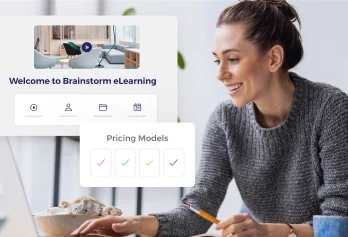Before the pandemic, The American Institute of Stress (AIS) reported 25% of people viewed their job as their number one stressor, and that work stress cost U.S. companies more than $300 billion each year due to lost productivity, employee turnover, accidents caused by stress and more. Now, amid new business challenges from COVID-19, work stress is amplified by sudden role changes, shifting responsibilities and disrupted revenue sources. As companies are leading their workforces through a changing business landscape, effective stress management is critical to sustain productivity and agility, while simultaneously supporting the well-being of your workforce.
AIS noted that nearly half of respondents said they need help learning how to manage their stress. That's where an effective employee training program can support them. By offering this training, you can teach stress management techniques and other coping skills that will support your employees' mental and emotional well-being. This article will share a few important and actionable recommendations.
Block off time to complete training
Workplace training is often piled on top of other responsibilities, which can be overwhelming for employees. Further, employees may not take the training seriously because it seems like a lower priority than their core work.
Blocking off time for employees to complete training will be beneficial in two ways:
- Training will not be an additional stressor for employees.
- Employees will understand that training is important and a priority.
Note: If you block off time for training, make sure project timelines take that into account so employees aren't overworked. Introducing microlearning modules can also support employee learning in short spurts while minimally impacting their workload.
Offer wellness courses
Seeing as so many people need support learning how to handle stress, an effective employee training program should offer stress management courses, along with other wellness training, through an intuitive LMS (learning management system). Tapping prebuilt content that covers stress, health, sleep, focus, emotional intelligence and more can save time for your L&D team while they're managing other critical tasks. And when you deliver wellness training through a robust LMS, you can more easily track course enrollments, completions and other insights compared to housing your training on multiple platforms. This data empowers your eLearning experts to make informed decisions to continuously improve your wellness training.
If you decide to offer wellness courses, it's important to make sure employees know this resource is available to them. Some ideas for improving employee awareness include:
- Scheduling automatic emails reminding learners of courses
- Displaying wellness courses on LMS billboards, so learners see these course options as soon as they log into the system
- Informing managers and team leaders about this resource, so they can recommend it to employees who might benefit
- Including information about wellness resources and how to access them in onboarding training
Now that the remote workforce is larger than it has ever been, it's also important to ensure employees can access their course library from home. Empower your learners to complete wellness courses using a mobile learning app, so they can benefit from these resources anytime, anywhere.
Train leaders to recognize employee stress
Recognizing stress in your employees is an important skill for managers, team leaders, project managers and others in leadership roles. It's difficult to manage stress at your company if no one knows where that stress is and what's causing it. Stress can be especially difficult to identify when your employees are working from home, even if only part time.
It may be worth conducting anonymous employee surveys about stressors and mental health to identify the sources of stress at your company. Then, you can identify where changes need to be made and what additional resources your employees may need.
Seek other kinds of feedback from your employees, too. Ask them if the training program you've designed is disruptive, overwhelming or otherwise stressful. Ask what kinds of support they need. People often know themselves well, and asking is better than guessing. Your LMS should provide customizable polls for easy distribution to specific learners or your full organization to solicit feedback on your training.
There's always more to learn about creating an effective employee training program. Providing safe spaces to seek continuous feedback—both anonymously and in person—will empower you to build trust among your team and improve your wellness efforts.
Connect with an Absorb LMS representative today to learn how we can support your company in managing employee stress.





